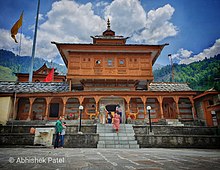Bhimakali Temple
| Bhimakali Temple | |
|---|---|
भीमाकाली मंदिर | |
 | |
| Religion | |
| Affiliation | Hinduism |
| Deity | Devi |
| Festivals | Navratri, Dussehra |
| Location | |
| State | Himachal Pradesh |
| Country | |
Location in Himachal Pradesh | |
| Geographic coordinates | 31°26′57.95″N 77°37′51.13″E / 31.4494306°N 77.6308694°E |

BhimaKali Temple is a Hindu temple at Sarahan in Himachal Pradesh in India, dedicated to the mother goddess Bhimakali, presiding deity of the rulers of former Bushahr State. The temple is situated about 180 km from Shimla and it is as holy as 51 Shakti Peethas.[1]
History
[edit]The Bhimakali Temple in Sarahan is an 800-year-old shrine dedicated to Goddess Durga, locally known as Bhimakali, and is revered as one of the 51 sacred Shakti peethas. Located near Chandigarh, it is a popular pilgrimage site. The present Bhimakali Temple, constructed in 1927, replaced the old temple nearby, which has an intriguing story. During the 1905 earthquake, the old temple tilted slightly but astonishingly straightened back during a subsequent tremor. Legend has it that the temple has deep foundations and includes a disused tunnel connecting it to the village of Ranwin, located a kilometer away. In ancient times, priests supposedly used this secret passage for entering and leaving the temple.
According to one legend, during Daksha Yagna, the Ear of Sati Devi fell here when Lord Vishnu cut the pieces of her body carried by heartbroken Lord Shiva. Other legend states that this area was under the rule of a Demon called Banasura, the great-grandson of king Prahlad an ardent devotee of Lord Vishnu. Due to the Usha-Anirudh affair, Lord Krishna fought here with him, and in this battle, Lord Siva stood against the former. The legend goes that the head of the defeated king Banasura was buried in front of the entry gate now marked as a raised platform to the first courtyard. After Banasura, Pradyumna son of Lord Krishna ruled this area. Then the ruling king constructed this temple recognizing Devi Bhimakali as the presiding deity of this area.
Gallery
[edit]-
Inscription on door to Bhimakali Temple - These gates were made in the reign of Raja Padam Singh 1927.
-
On one of the doors of the temple
-
Inner courtyard of Bhimakali Temple
-
Bird's eye view of Bhimakali temple during monsoon
-
Bhimakali Temple in the background
-
A temple alongside the Bhimakali temple
-
Bhimakali Temple at Sarahan
References
[edit]- ^ Prem N. Nag, Dainik Jagran, 26 August 2007








